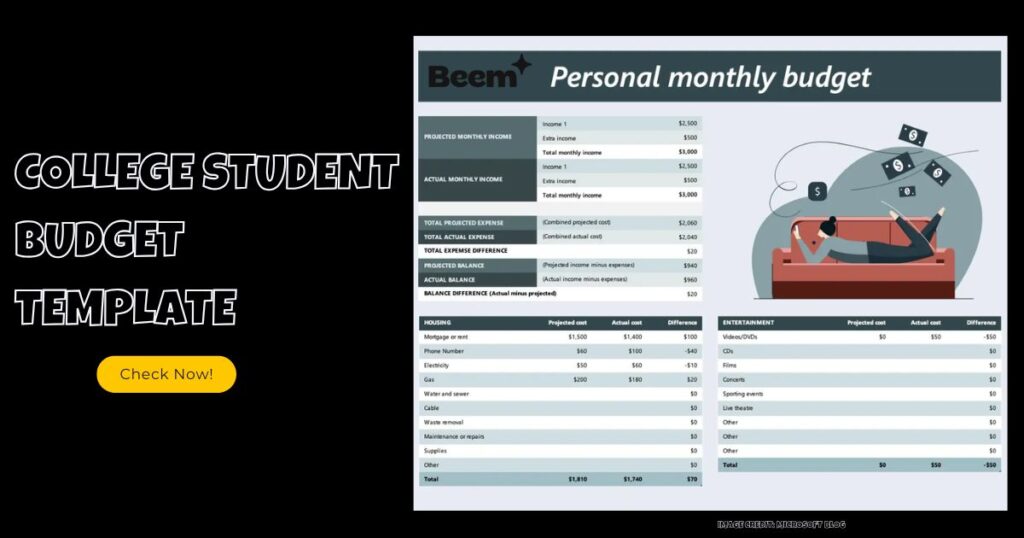In This Blog, You Will Get Information on College Student Budget Template
Navigating finances in college can be challenging, but a structured college student budget template makes it manageable. This comprehensive guide helps you organize your financial responsibilities efficiently, from tuition to daily living expenses.
Managing money as a college student can be challenging, especially with tuition fees, rent, groceries, and social activities all demanding a slice of your income.
A College Student Budget Template can help you keep track of your expenses, set savings goals, and avoid unnecessary debt.
Whether you’re a freshman adjusting to college life or a senior preparing for post-grad expenses, this guide will provide you with a practical USA College Student Budget Template and essential tips for effective money management.
Importance of a Student Budgeting Worksheet
A student budgeting worksheet is essential for managing your limited financial resources. It helps you track expenses, understand your spending habits, and ensures that your financial aid, scholarships, and income are wisely allocated.
Why Use a College Expense Tracker?
Implementing a college expense tracker lets you monitor exactly where your money is going. By tracking your expenditures, you can identify areas where you can cut costs and redirect savings toward important needs like tuition or textbooks.
Creating a Monthly Budget Planner for Students
A monthly budget planner for students allows you to project and control monthly expenses. Include these major categories:
- Tuition and fees
- Rent or dorm room expenses
- Food and groceries
- Transportation
- Books and academic supplies
- Personal expenses and entertainment
- Savings
Components of a Personal Finance Template for College Students
A personal finance template for college students typically includes:
- Income sources (part-time job, family support, financial aid)
- Fixed expenses (rent, subscriptions, tuition)
- Variable expenses (food, utilities, entertainment)
- Emergency funds and savings plans
- Debt management (student loans, credit card)
University Student Expense Sheet: Tracking Every Penny
Your university student expense sheet must capture all financial transactions. Categorize expenses and update regularly to avoid overspending. Key benefits include:
- Financial clarity
- Reduction in impulsive spending
- Enhanced savings
Educational Budgeting Tool: Your Financial Companion
Utilizing an educational budgeting tool can automate tracking, provide insights into spending trends, and help maintain financial discipline. Apps or online platforms specifically designed for students are user-friendly and offer great financial management features.
Scholarship and Grant Tracking: Maximize Your Resources
Including a section for scholarship and grant tracking ensures you never miss important deadlines or lose track of disbursements. Detail information such as:
- Scholarship or grant amounts
- Application deadlines
- Renewal requirements
- Conditions and criteria
Dorm Room Budgeting Guide
Living on-campus can impact your finances significantly. A dorm room budgeting guide includes planning for:
- Room rent
- Utilities (if applicable)
- Food plans or groceries
- Dorm furnishings
- Personal care items
- Entertainment and leisure
Tips for Dorm Room Budgeting:
- Buy in bulk or during sales.
- Share expenses with roommates.
- Choose budget-friendly meal plans.
Campus Finance Planner: Managing On-Campus Expenses
A campus finance planner helps manage everyday expenses and extracurricular activities. Regularly updating this planner ensures your academic life isn’t disrupted by financial stress.
Essential Elements of a Campus Finance Planner:
- Dining expenses
- Library and lab fees
- Social events and clubs
- Transportation and commuting costs
Tuition Payment Organizer
Tuition payments are significant expenses. A tuition payment organizer tracks payment schedules, amounts due, and payment methods, ensuring timely payments to avoid penalties.
How to Organize Your Tuition Payments:
- Record payment dates and amounts.
- Note payment methods (online, check, direct deposit).
- Keep receipts for verification.
Why Do You Need a College Student Budget?
A budget is not just about restricting your spending—it’s about knowing where your money is going and making informed financial decisions.
Here’s why having a College Student Budget is essential:
- Prevents overspending: Helps you control unnecessary expenses.
- Avoids debt: Keeps you from relying too much on credit cards or loans.
- Encourages savings: Allows you to set aside money for future needs.
- Reduces financial stress: Gives you peace of mind about your finances.
- Improves financial habits: Helps you build strong money management skills for life.
How to Create a College Student Budget

Creating a College Student Budget Template USA involves tracking your income, listing expenses, and setting financial goals.
Here’s a step-by-step guide:
1. Identify Your Income Sources
Your income as a student may come from different sources, such as:
- Parental support
- Part-time jobs or internships
- Scholarships and grants
- Student loans
- Side hustles (freelancing, tutoring, etc.)
- Work-study programs
Estimate your monthly income and write it down in your budget template.
2. Categorize Your Expenses
Divide your expenses into fixed costs (essentials) and variable costs (discretionary spending).
Fixed Costs (Essential Expenses)
- Tuition & Fees: If not covered by scholarships or grants.
- Rent & Utilities: Housing, electricity, water, and internet.
- Food & Groceries: Meal plans or grocery shopping.
- Transportation: Public transit, gas, or car insurance.
- Health Insurance & Medical Expenses: College-provided or private insurance.
Variable Costs (Discretionary Spending)
- Entertainment & Social Activities: Movies, concerts, or dining out.
- Clothing & Personal Items: Apparel, toiletries, and accessories.
- Technology & Subscriptions: Streaming services, software, or apps.
- Emergency Fund & Savings: Setting money aside for unexpected expenses.
3. Set Spending Limits
Now that you know your income and expenses, allocate specific amounts to each category. A 50/30/20 budgeting rule can be helpful:
- 50% for necessities (rent, food, transportation, insurance, etc.)
- 30% for personal expenses (entertainment, hobbies, and non-essentials)
- 20% for savings & debt repayment
4. Track Your Spending
Use budgeting tools, spreadsheets, or apps to track daily expenses. Some popular apps include:
- Mint
- YNAB (You Need A Budget)
- Beem’s Budget Planner
- PocketGuard
5. Adjust and Optimize
Review your budget regularly and make adjustments where necessary. If you overspend in one category, cut back on non-essentials.
List Of College Student Budget Template (USA)
Here’s a simple budget template list you can use to track your income and expenses:
1. Microsoft Budget Templates
Microsoft provides a range of free, customizable budget templates tailored for various financial needs, including personal monthly budgets, college savings plans, and wedding expenses. These templates offer a clear overview of expenses and financial goals, making it easier to manage and track spending.
2. BestColleges.com College Budgeting Worksheet
Specifically designed for college students, this budgeting worksheet helps track different income sources—such as jobs, parental support, grants, and loans—while managing fixed and variable expenses like tuition, housing, groceries, and entertainment.
3. GetSmarterAboutMoney.ca Student Budget Worksheet
Offered by the Ontario Securities Commission, this student budgeting tool assists in planning and monitoring monthly finances. It covers essential expense categories such as tuition, rent, transportation, and personal spending, encouraging financial literacy and smart money management.
4. Yale University’s Budgeting Template – Google Spreadsheet
Created with simplicity in mind, this student-friendly college budgeting template focuses on daily financial tracking to support long-term money management goals. It’s an excellent starting point for those new to budgeting, providing a user-friendly approach to managing everyday expenses.
Best Practices for Sticking to Your Budget For College
- Set financial goals for saving, investing, or reducing debt.
- Use cash or debit instead of credit cards to avoid debt.
- Take advantage of student discounts for shopping, entertainment, and travel.
- Cook at home instead of eating out.
- Buy used or digital textbooks to save on book expenses.
- Look for campus resources such as free fitness centers, health services, and academic support.
- Find free or low-cost entertainment like campus events, movie nights, or museum visits.
Why You Need a College Student Budget Template?
Managing finances in college can be overwhelming, with expenses like tuition, rent, groceries, and social activities quickly adding up. A College Student Budget Template helps students take control of their money by tracking income and expenses, ensuring they stay within their financial limits. Without a budget, it’s easy to overspend, accumulate debt, or struggle to cover essential costs.
A budget template provides a clear financial roadmap, helping students allocate funds for necessities while setting aside savings for emergencies or future needs. It encourages responsible spending habits and reduces financial stress, allowing students to focus on their studies rather than worrying about money.
Additionally, using a budget template promotes financial literacy, teaching students essential money management skills that will benefit them long after graduation.
By categorizing expenses and monitoring cash flow, students can identify areas where they can cut costs—such as opting for used textbooks or cooking at home instead of eating out.
Whether a student receives financial aid, works part-time, or relies on family support, a USA College Student Budget Template ensures that every dollar is used wisely.
Ultimately, budgeting fosters independence, prevents unnecessary debt, and sets students on the path to long-term financial success.
Most Common & Important Queries About College Student Budget Templates
What is a College Student Budget Template?
A College Student Budget Template is a structured format that helps students track their income and expenses, ensuring financial stability while in college.
How can I create a college student budget?
Start by identifying your income sources, categorizing your expenses, setting spending limits, tracking your spending, and adjusting your budget as needed.
What are the most common expenses for college students?
Common expenses include tuition, rent, food, transportation, insurance, entertainment, and technology subscriptions.
What budgeting apps are best for college students?
Popular budgeting apps include Blitz, & Beem’s Budget Planner are best and trusted for USA college students.
How can I save money as a college student?
Use student discounts, cook at home, buy used textbooks, attend free campus events, and set aside money for savings.
Should I get a credit card in college?
A credit card can help build credit if used responsibly, but it’s best to avoid high-interest debt and only spend what you can pay off monthly.
How much should I budget for entertainment as a student?
Entertainment should be a small percentage of your budget, ideally under 10-15% of your monthly income.
What happens if I overspend in my budget?
If you overspend, cut back on non-essential expenses and adjust your future spending habits.
Is it possible to graduate college debt-free?
Yes, through scholarships, grants, part-time work, budgeting wisely, and minimizing student loans.
Most Searched Topics At Beem: How to Get 500 Dollars Fast | How To Get $5000 Personal Loan | Sofi Personal Loan
People Also Read: How to Get a No Credit Check Cash Advance Instantly | Cash Advance Loans with Same-Day Approval | Cash Advance Apps Like Dave
Learn About Personal Loans: How to Get a Personal Loan from SoFi? | How to Get a Personal Loan from Axos?
What People of Beem Are Reading Now: Emergency Loans | Cash Advance Apps of 2025 | Instant Cash Advance vs. Payday Loans | What Is An Instant Cash Advance And How Does It Work?



